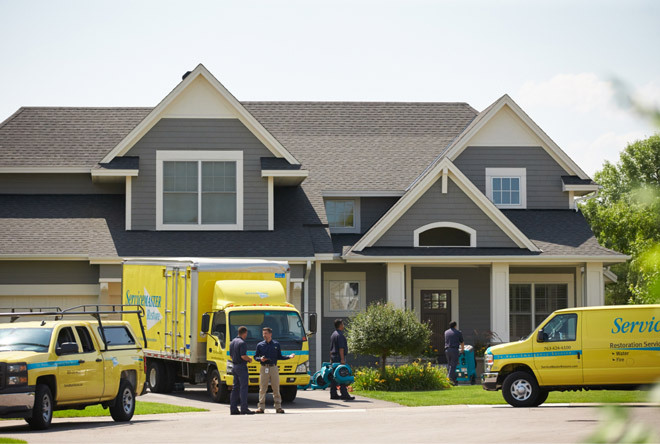Mold Detection & Removal
One of the worst contaminants known is the silent but dangerous growth of mold. Mold can grown indoors on wet or damp surfaces, such as wallpaper, ceiling tiles, carpets, insulation material, wood and drywall. It can start to grow within 48 hrs. and if left unchecked, can have serious impacts on both your quality of life and your home’s physical structure.
Mold is present everywhere in nature, but when it finds it way into your home it can be a major problem.
Regardless of the cause, our experts provide a comprehensive mold remediation process to help eliminate the problem by:
- Locating the mold and the water sources that feed mold
- Assessing the damage caused by the mold
- Isolating and containing the mold by using techniques like physical barriers and negative air pressure to prevent it from spreading
- HVAC system
- Removing mold with antimicrobial and antifungal treatments
- Disposing of mold-infested porous materials
- Cleaning, sanitizing and deodorizing belongings as needed
- Repairing and reconstructing damaged areas to restore your home
Why is mold a problem? - Structural damage
- Molds gradually destroy the things they grow on and can grow anywhere:
- Foundation
- Roof
- HVAC system
- Drywall
- Gutters
- Furnishings and more
Why is mold a problem? - Health problems
- In your home, all molds have the potential to cause side effects:
- Headaches
- Breathing difficulties
- Skin irritation
- Allergic reactions
- Aggravation of asthma symptoms
What is mold?
- Mold is a fungus that can be found both indoors and outdoors. No one knows how many species of mold exist, but estimates range from tens of thousands to perhaps three hundred thousand or more. Mold spreads and reproduces by making spores. Spores can survive conditions that are too sunny, hot, cold, dry, or wet for mold to grow. When spores are released, they can be carried by air or water to new locations.
Where does mold come from?
- Molds thrive in moist environments created by a flood, slow leak, broken pipe or just high humidity. Without water mold cannot grow. Mold also needs a food source, oxygen and a temperature between 40 degrees and 100 degrees F.
How does mold spread?
- For molds to grow and reproduce, they only need an organic food source, such as cellulose, which is found in building materials like wood and drywall.
Are there any warning signs to look for?
- If there are dark spots on your ceiling, floors or walls, this is a sure sign of mold growth. Musty odors and mildew are often signs that mold may be growing in your home. Respiratory and allergy symptoms such as coughing, sneezing, trouble breathing, and wheezing are common indicator of mold growth as well. Also, high humidity levels such as condensation on glass and metal surfaces are a warning sign of mold.
The special challenges of mold:
- Mold is an issue that can affect the health of your family and compromise the physical structure of your home.
- Mold and mildew grow best in warm, damp and humid conditions.
- Mold may never become visible, since it can grow in the walls and under the floor.
- If more than days have passed, any wet materials will be affected by mold, even if it’s not yet visible.
- Whether you can see a problem or merely suspect its presence, call a professional.
- Some home remedies such as bleach can cause more problems.
Odor damage caused by water and mold:
- Odors stemming from water and mold damage are an invisible threat that can disrupt your life and your health. In particular, smoke and odor particles continue to be airborne many days after a fire has stopped.
- Where there are pipes, there is always an opportunity for leakage, water damage and mold growth. If you live in an area prone to natural flooding disasters like hurricanes, tidal swells and tsunamis, you are also at high-risk for water damage. Without immediate remediation, floods and leaks can damage the structure, foundation and integrity of your home, cause a persistent mildew smell and encourage the growth of pesky, sometimes dangerous mold spores.
Odor removal techniques:
- Air scrubbers use high-efficiency particulate air (HEPA) filtration to remove odorous particles from the air, enhancing the efficiency of cleaning and clearing the air for safe breathing.
- Thermal fogging neutralizes odor, using a strong deodorizer that penetrates everywhere the smoke traveled
- Ozone in an oxidizing agent produced by a portable ozone generator
- Hydroxyl generators use hydroxyl radicals to eliminate odor from the surrounding areas.
Can I get rid of mold by myself?
- Doing it yourself is not recommended. At ServiceMaster, our experts have completed intensive mold remediation training as well as detailed instruction in the proper procedures for handling mold claims.
Take action at the first sign of mold. If the mold growth already seems large, call the experts at ServiceMaster Restore.


